Tabela de Safras
Ficha de Degustação
Pesquisar no site:
Mount Athos: Organic Wine in a Holy Past
19-maio-12

Carlos José Arruda
Arquiteto, web designer, enófilo, professor, intérprete francofone, consultor comercial e autor de artigos sobre vinhos, criador e diretor do site Academia do Vinho.
MOUNT ATHOS
In north Greece, under this name we find one of the fingers of Central Macedonian peninsula, a territory owned and managed by a group of monasteries branched to the Turkey Orthodox Church. This 1,200 years old monastic community, dedicated to the perpetual glorification of the Mother of God, lives completely isolated from the world in a naturally kept environment for all that time.
In the past, thousands of monks made here their religious studies. With their black clothing, straight hats and long beards, they are time actors that preserve this historic and natural patrimony, while they go deep in this religious life.
Mount Athos is a spine from an underwater elevated peninsula that goes 50 kilometers through the Mediterranean, with altitudes ranging between 200 and 600 meters, culminating at Mount Athos itself, a glorious peak 2,030 meters high, at the south end of the peninsula. The monks name this peak as Holy Mountain.
Everything here is managed, checked and also done by the monks. Vegetarians, they planted, they cooked, they produced their wine and olive oil, and followed a simple life of meditation and study for centuries, with the special consequence of maintaining this territory absolutely virgin, natural and untouched by modern civilization, obviously avoiding to be polluted or destroyed by it. I can wonder how much international resorts could dream of this place.
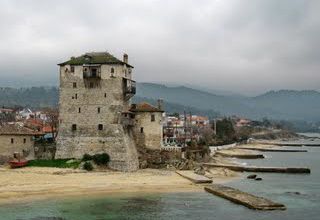
Ouranopouli, a Byzantin tower dominating the port where boats leave to Daphni port and the monastaires visit (photo Carlos Arruda)
Leaving Thessaloniki, we cross Central Macedonia up to the west side, arriving at the beginning of this long peninsula. An ancient Byzantine tower, Ouranopoli, marks a small port, where authorized visitors take a boat that follow the coastline down for 25 kilometers to reach another port called Daphni. From here, a small bus makes a visit tour to some monasteries that end at Mount Athos peak, where a small church marks the Holy Mountain. Only men are allowed to enter the House of The Mother of God at the monastic community of Mount Athos, according to orthodox religion precepts.
Sadly the rainy weather, cold and foggy, blocked a sight of the magnificent view from the Mediterranean and Macedonian peninsula. No problem, the beauty of this place is at the interior, as we (almost) say about ourselves.
Here, there are 20 monasteries, 17 of them belong to the Greek Orthodox Church, one to the Russian Church, one to the Bulgarian Church and one to the Serbian Church. Other from that, there are smaller cloisters scattered in Mount Athos that belong to the 20 main ones.
The monasteries are very old, and have been rebuilt and maintained over and over across the centuries. Impressing fortresses landed on rocky walls, they are witnesses of ancient times that are still alive and work (almost) the same way ever since. Electricity arrived here only 15 years from now!
METOXI CHROMITSA
With the bad weather, no boat. We will visit only the first location in the peninsula, Chromitsa, where 40 years ago Tsantali, authorized by the monks, planted vineyards and start producing wines here under the label Metoxi Chromitsa. This is the name of the place where is located the first cloister, St. Panteleimon, that belongs to the Russian Church.
We enter the closed perimeter that defines the area under monastic jurisdiction and we take our route. After crossing two small water streams, we climb tortuous narrow sandy roads, full of holes and water, thanks to the last rainy days.
After the second curve, nothing remind us the civilization: time seems to have been rewound some centuries, because we can only see bushes of so many colors and shapes, lots of olive trees and scary curves as we progress climbing this rustic path over and over. If we had to travel to the end of the peninsula in these roads, we would spend 10 hours in a 4x4 vehicle. In the past this trip took one week on charged donkeys.

One of the orthodox monasteries at Mount Athos (photo Mount Athos Area Org)
Far and above, we see ancient stone buildings, church towers and vineyards. All along the way, small oratories in carved wood mark the landscape with their bright colors, remembering us the purpose of this place.
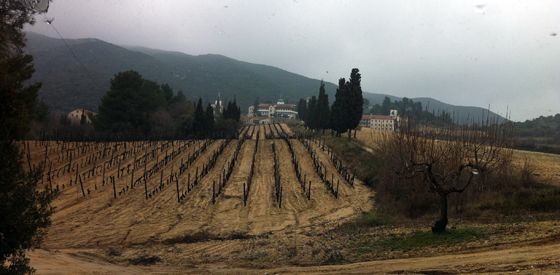
The vineyards up the hills and at large the Saint Pateleimon monastery group (photo Carlos Arruda)
THE VINEYARDS
In the middle of the way up we reach the first vineyards: yellow sandy stripes, with granite gravel, make a carpet to rows of naked wine plants, almost black for being wet. Topography here is tortuous, so the parcels are separated one from each other, in terraces and hills no bigger than a few hectares, sometimes less than this. Viniculture here is very hard, everything is made bay hand, or with small vehicles and machines. Vineyards 10, 20 and even 40 years old are mixed, and also the varieties: Xinomavro, Limnio, Cabernet Sauvignon, Grenache Rouge, Assyrtiko, Athiri, Chardonnay

Vineyards up to 40 years old occupy sectors of the hills (photo Carlos Arruda)
Very important matter: as this place was (and still is) kept untouched for centuries, all the territory is organic certified, providing healthy, sustainable and blessed vineyards. This partnership took years to be effective, but today Tsantali has a high reputation at the monastic community because of his work in recuperation and conservation of the territory and historic patrimony. Russian president Vladimir Putin, visiting this place, declared in free will his gratitude to Tsantali family for their contribution.
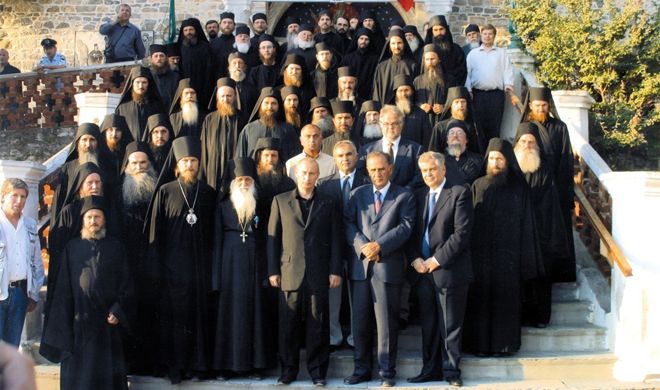
President Putin visiting the monastery and the Tsantali project (photo Carlos Arruda)
THE TIME STOPS RUNNING
Short break in a tiny stone house, completely restored by Tsantali, located in a privileged promontory with an impressing view of the Mediterranean, the small port with the tower, the vineyards and the closer monasteries. Originally this building was abandoned, and remained invisible covered with bushes for unknown time, but today it is used as a meeting place for invited Tsantali visitors, where tastings and meals htake place by the stone terrace, under the vine pergola, all this very rustic and well maintained.
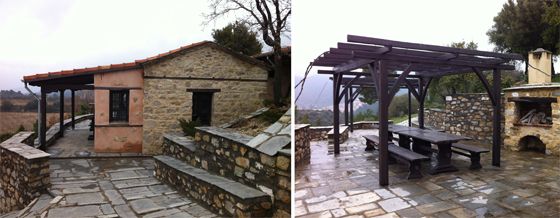
The small house host invited peopls to tastings with a Mediterranean sight (photo Carlos Arruda)
Once again we don´t know where time has stopped, so big is the silence and the peaceful sensation of this place. We´re waked back to the future by Dimitri, the driver, that bring us Tsipouro (the Greek grappa), a Greek coffee (made with a thick powder, without filtering) and a cube of the Greek Delight (in fact, Turkish Delight), a tasty soft jelly covered with sugar powder.
This toast is a tradition in Mount Athos, and with the cold sea breeze and the extraordinary sight from this mysterious place, we enjoy some silent intimate moments, blessed by these Greek flavors.
Before we leave, Dimitri picks a heavy stone plate (eight kilos or more) that was moved down by the night wind over the roof, breaking several tiles. The free nature forces are not shy here.
We keep climbing, bordering more and more vineyards, until the highest ones. The entire combined set makes 100 hectares (!), located up to 350 meters high, just in front of the sea. The cold sea breeze engulfs the area, showing the essence of the terroir climate.
Here we have a group of ancient buildings that makes the Cloister of the St. Panteleimon Monastery.
Tsantali is restoring a destroyed part and aims to operate here a wine producing facility, avoiding the transportation (and stress) of the grapes from Metoxi Chromitsa to their main facility at Halkidiki, 100 kilometers away. ..
SANT PATELEIMON
The vision of the monastic group of buildings is marked by the rustic look and the delicate peaceful ambience, where time flows slowly and everything seems being there ever. The silence brings us just the wind and distant seagulls, making this quiet moment a rare privilege in our modern world. The monks enjoy it for centuries...

The monastery buildings, destroyed by time, are being restored by Tsantali (photo Carlos Arruda)
We are in the front block, where destroyed parts, including the church, remind us of their age. The front building is restored, hosting an underground with thick stone walls and arches, where the low temperature, tanks and barrels show us the future use: a producing and aging wine facility and also a tasting dinner hall to receive wine world visitors. The old stones still keep their secrets and create a cozy and mysterious ambiance, very suited for the wine, I guess.
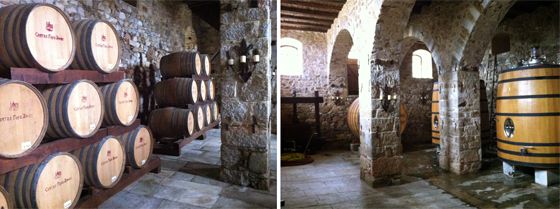
The old caves will soon host a producing unit for local Metoxi wines (photo Carlos Arruda)
At the upper stage, the tiny rooms once used by the monks where restored and furnished to work as accommodations, and some of them were grouped to form rooms (less) smaller than the standard. A simple kitchen, a living room and the traditional Macedonian Greek balcony, very well adapted to the hot weather and also to this privileged Mediterranean sight. For a while we can imagine the quiet and simple life of this monastic people, and we ask ourselves about the modern paraphernalia we have today.
A lot of work, a lot of investments, and so much respect to nature and religion mark this unique initiative, softly building a commercial wine production inside this difficult and special territory. Respecting the religious precepts, the working staff at the vineyards adopt also the vegetarian food, so delicious here with Mediterranean vegetables, olives and olive oil locally produced.
THE TERROIR AND THE WINES
This terroir produces high quality wines, one white and three reds, all organic, very qualitative and - above all - very representative of the Greek viniculture, bringing this historic style from varieties as the powerful Limnio and Xinomavro and the deliciously fresh Assyrtiko in slightly modern assemblages with French grapes, more suited for foreign consumers.
The weather conditions here are near perfect, with bright summer sunshine (more than 2,000 hrs / year), few rainfalls (151 mm / year) and fresh coastal maritime breezes. This combination provides the perfect conditions for slow and profound grape maturation, with the fresh nights contributing to an excellent development of elegance and aromas.
METOXI CHROMITSA WHITE
A blend of Assyrtiko and Sauvignon Blanc from low production vineyards, slowly fermented in low temperatures. With tipical tropical fruit notes, shows freshness and complexity, with a tasty and lingering finish.
METOXI CHROMITSA RED
A blend of Cabernet Sauvignon and Limnio, with extended maceration, is aged in high toasted barrels for 8 months. With deep colour, shows rich red fruit and good spices. Soft and complex, with a slight rustic finish and chocolate notes.
METOXI CHROMITSA X RED
A blend of Xinomavro (20%), Limnio (40%) and Cabernet Sauvignon (20%), located in stony soil with free draining. Fermented in steel vats in middle temperatures, it is matured in french barrels (45% new) and has limited production. Strong, tasty and velvety, shows spices and strong fruit, with soft tannins, floral notes and tomato paste from Xynomavro and a complex and lingering finish.
METOXI CHROMITSA X WHITE
A blend of 20% Athiri, 50% Assyrtiko and 30% Sauvignon Blanc, it`s a dense and complex white, with ripe pears, peaches, melon and grapefruit and citric notes. Rich, balanced and well structured, this is a wine that reflects very well the terroir potential of Mount Athos.
METOXI CHROMITSA MOUNT ATHOS GOLD
A blend of Cabernet Sauvignon (70%) and Limnio (30%) , fermented in small vats with long maceration. matured in new french oak (mixed origins) for 36 months, shows deep colour, intense red fruit, spices and vanilla. A fine and robust wine, with elegant tannins and soft finish.
These wines are perfect ambassadors of the millenary and rustic Greek viniculture, bringing to the world the history, the tradition and the strength of so old terroirs. Yamas!
Quer entender de vinhos?
Conheça o mais completo curso online
Descobrindo o vinho
© 1997-2025 Academia do Vinho
Aprecie o vinho com moderação
Nenhuma reprodução, publicação ou impressão de textos ou imagens deste site está autorizada